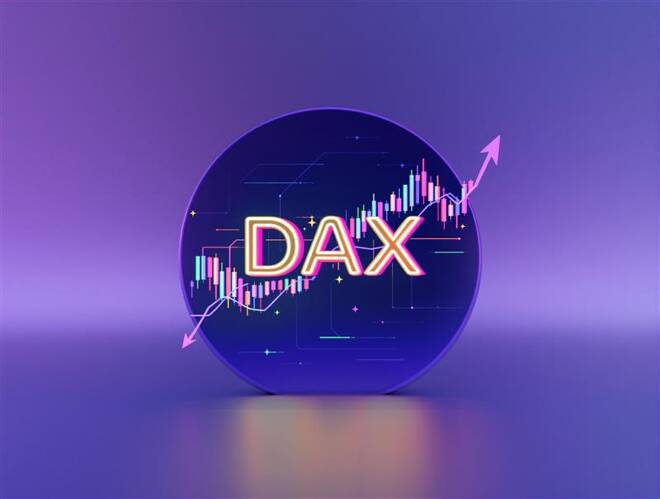Advertisement
Advertisement
Dax Index News: German Data, ECB Rate Bets, and Trade Talks Fuel DAX Forecast
By:
Key Points:
- DAX surged 1.62% on June 27 after a US-China trade deal lifted sentiment and boosted auto and export-focused German stocks.
- Investors eye German inflation and retail sales data for clues on ECB’s rate path and market outlook.
- A dovish ECB and a potential US-EU trade deal could drive the DAX toward 24,500 in the near term.
DAX Surges on US-China Trade Deal; ECB and German Data in Focus
The US administration announced a trade deal with China set to boost Chinese exports of rare earth minerals to the US, lifting sentiment. On Friday, June 27, the DAX rallied 1.62%, building on Thursday’s 0.64% gain and closing at 24,033.
CN Wire reported:
“China will, in accordance with the law, approve export applications for controlled items that meet relevant requirements. The US side will accordingly lift a series of restrictive measures imposed on China.”
Sector Performance: Auto Stocks Shine on US-China Trade Developments
Germany’s China-sensitive sectors were the direct beneficiaries of US-China trade headlines. Auto stocks led the gains, with Daimler Truck Holding soaring 6.14%. BMW and Mercedes-Benz Group jumped 5.32% and 4.85%, while Volkswagen and Porsche also posted solid gains.
Adidas rallied 3.85% after Nike topped Q4 earnings and revenue forecasts.
German Retail Sales and Inflation in Focus
On Monday, June 30, key German economic indicators could fuel speculation about ECB rate cuts. Economists forecast retail sales to rise 0.5% month-on-month in May after sliding 1.1% in April. A pickup in consumer spending may fuel demand-driven inflation, potentially delaying ECB rate cuts.
However, inflation figures will likely have greater weight on the ECB’s policy stance. Economists expect the annual inflation rate to rise from 2.1% in May to 2.2% in June. A higher inflation reading could temper ECB rate cut bets and pressure the DAX. Conversely, a drop to or below the ECB’s 2% inflation target would support a more dovish ECB rate path, driving demand for DAX-listed stocks.
Wall Street Moves: S&P 500 Hits Record High on AI Bets and Fed Rate Cut Hopes
US markets advanced on June 27, extending gains from June 26, with rising hopes of a Q3 Fed rate cut fueling demand for risk assets. The Dow rallied 1%, while the Nasdaq Composite Index and the S&P 500 both posted gains of 0.52%.
Softer-than-expected US personal income and spending figures offset a higher Core PCE Price Index, supporting a more dovish Fed rate path. Falling income and spending may ease inflationary pressures. Friday’s data followed US data on Thursday that showed the economy contracted by 0.5% quarter-on-quarter in Q1, revised from a preliminary 0.3% contraction. In Q4, the US economy expanded by 2.4%.
According to the CME FedWatch Tool, the chances of a September Fed rate cut rose from 69.7% on June 20 to 91.4% on June 27.
Several Fed speakers, including Michelle Bowman, Austan Goolsbee, Mary Daly, and Susan Collins, supported further policy easing, contributing to the jump in rate cut bets.
US Manufacturing Sector and Trade Developments to Drive Sentiment
Later in the June 30 session, Chicago PMI and the Dallas Fed Manufacturing Index will spotlight the US economy. Economists expect the Chicago PMI to rise from 40.5 in May to 42.7 in June and the Dallas Fed Manufacturing Index to edge higher. However, economists expect both reports to indicate continued contractions, supporting a more dovish Fed.
Beyond the numbers, trade developments will be crucial for the DAX. Progress toward a US-EU trade deal would have more impact on the DAX than German economic data, while failed talks could pressure German stocks.
Outlook: Key Catalysts for the DAX
The DAX’s near-term trajectory hinges on German inflation data, US-EU trade headlines, Middle East-related news, and central bank rhetoric.
- Bullish Case: A US-EU trade deal, easing Middle East frictions, softer German inflation, and dovish central bank cues could send the DAX toward 24,500.
- Bearish Case: Breach of the Iran-Israel ceasefire, failed US-EU trade talks, hotter German inflation, or hawkish central bank signals may push the DAX toward 23,500.
At the time of writing on June 30, the DAX futures rose 90 points. The Nasdaq 100 was up 126 points. Futures markets signaled a positive start to the week.
Technical Setup Suggests Cautious Optimism
After Friday’s rally, the DAX trades well above the 50-day and 200-day Exponential Moving Averages (EMA), affirming bullish momentum.
- Upside Target: A breakout above the June 27 high of 24,041 could enable the bulls to test the June 5 high of 24,479. A sustained move through 24,479 could pave the way to 24,750.
- Downside risk: A drop below 23,750 could expose the crucial 23,500 support level and the 50-day EMA.
The 14-day Relative Strength Index (RSI), at 58.13, suggests the DAX could climb to 24,479 before entering overbought territory (RSI > 70).
German Data, Trade Headlines, and Central Banks
Traders should closely track Middle East-related news, US-EU trade developments, key German data, and central bank guidance. Renewed Iran-Israel tensions and failed US-EU trade talks could pressure sentiment, overshadowing economic data and central bank signals.
Explore our exclusive forecasts to assess whether improving trade sentiment could lift the DAX to new highs. Refer to our latest forecasts and macro insights here for further analysis, and consult our economic calendar.
About the Author
Bob Masonauthor
With over 28 years of experience in the financial industry, Bob has worked with various global rating agencies and multinational banks. Currently he is covering currencies, commodities, alternative asset classes and global equities, focusing mostly on European and Asian markets.
Advertisement
